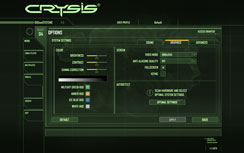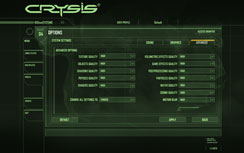HIS Radeon HD 4850 IceQ 4 TurboX 512MB
Manufacturer: HISUK Price (as reviewed): £135.00 (inc. VAT)
US Price (as reviewed): $189.99 (ex. Tax)
Core Clock: 685MHz
Memory Clock: 2,200MHz (effective)
Memory: 512MB GDDR3
Warranty: Three years (parts and labour)
The Radeon HD 4850 is arguably the best bang for buck graphics card on the market at the moment and it has been a favourite in the bit-tech offices ever since its release. The cheaper models are currently sitting just over the £100 mark, with some sub-£100 deals if you're prepared to look around.
However, one thing that has concerned us—and many like-minded hardware enthusiasts—is the stock cooler's performance. Although the cooler is quiet, the GPU and memory end up running rather hot because there isn't a massive amount of airflow – we had recorded temperatures over 80°C when the stock-cooled card is idling on the Windows desktop.
With that said, 80°C isn't hot enough to cause system instabilities, but it is a little warm for our liking. This can, of course, be fixed with a simple tweak to the default fan speed using either Catalyst Control Center profiles or a utility like RivaTuner (our favoured method), but that results in more noise. That presents problem number two – most enthusiasts care about noise these days, so any increase in noise is generally a last resort.
Many would prefer to look for a third-party cooler that will enable them to overclock while keeping noise down to a minimum. This is where board partners have carved themselves a niche in a crowded market – many now have own-design Radeon HD 4850s and 4870s with custom cooling solutions and factory overclocks.
One AMD board partner that has been doing this for a long time is HIS, famed for its IceQ series of graphics cards fitted with custom coolers. Today, we've got the company's latest addition to its IceQ range, the Radeon HD 4850 IceQ 4 TurboX 512MB. It sports a fairly decent overclock on both the core and memory—the former increased from 625MHz to 685MHz (a 9.6 percent increase) and the latter pushed up by 10.8 percent from 1,986MHz to 2,200MHz.
Aside from the healthy ten percent overclock, the biggest selling point for the card is of course the IceQ 4 cooling solution, which covers almost the whole card. It's a familiar design that works well and is inaudible above other system noise at both idle and load – it pulls air in through the radial fan and then spits it out the back after flowing over an array of aluminium fins and copper heatpipes.
In terms of temperatures, the HIS Radeon HD 4850 IceQ 4 TurboX idles at around 49°C and the highest temperature we witnessed during our testing was about 63°C. At this temperature, the fan spun up from the default 40 percent to between 60 and 75 percent, but still remained quiet enough for it to not be noticed above other system noise because of its low pitch. The differences between this version and the older model featured on the HIS Radeon HD 3850 IceQ 3 TurboX is that there's an additional heatpipe and an increased surface area for the fins the two heatpipes transfer heat to.
HIS has dyed the board blue to fit in with the rest of the card's aesthetics. It fits in really well with the UV-reactive heatsink shroud, boltgun metal PCI bracket and twin gold-plated DVI connectors. The two black and gold DVI connectors are joined by a standard HDTV out connector—also in black—that sits in between the two digital connections.
The bundle is unsurprisingly lacklustre, but everything you'll need to get the card running is included. There's a DVI-to-HDMI dongle, a DVI-to-VGA converter, a six-pin PCI-Express supplementary power adapter, a TV-out to composite adapter and a CrossFire connector. In addition, HIS includes a driver/utility CD, a paper manual and an integrated screwdriver/spirit level. Aside from the screwdriver—which is a bit of a novel inclusion—it's clear that HIS prefers to spend more on spicing up the card itself than it does on the bundle. That's the way we like to see it.
Warranty:
HIS offers a three year limited warranty on all of its products that covers parts and labour. During the first year, this warranty is held with the retailer where you purchased the card and the remaining two years are handled by the manufacturer.
One thing that is definitely noteworthy is the fact that the warranty doesn’t start when you purchase the card, instead it starts from the day when the card was manufactured – that’s not ideal if the card is going to sit in a warehouse for six months. Despite that though, a good thing with HIS’s warranty terms is that you’re able to transfer this warranty should you choose to sell the card at a later date – this should sweeten the deal a little bit even if you’re put off by when the warranty term starts.
One thing that is definitely noteworthy is the fact that the warranty doesn’t start when you purchase the card, instead it starts from the day when the card was manufactured – that’s not ideal if the card is going to sit in a warehouse for six months. Despite that though, a good thing with HIS’s warranty terms is that you’re able to transfer this warranty should you choose to sell the card at a later date – this should sweeten the deal a little bit even if you’re put off by when the warranty term starts.
How we tested
As always, we did our best to deliver a clean set of benchmarks, with each test repeated three times and an average of those results is what we’re reporting here. In the rare case where performance was inconsistent, we continued repeating the test until we got three results that were consistent.The tests performed are a mixture of custom in-game timedemos and manually played sections with FRAPS to record the average and minimum frame rates. We strive to not only record real-world performance you will actually see, but also present the results in a manner that is easy to digest.
ATI Test System
Intel Core 2 Extreme QX6850 (operating at 3.00GHz – 9x333MHz); Asus Maximus Formula motherboard (Intel X38 Express with two PCI-Express 2.0 x16 slots); 2x 2GB Corsair XMS2-6400C5 (operating in dual channel at DDR2-800 5-5-5-12-1T); Seagate Barracuda 7200.9 200GB SATA hard drive; Enermax Galaxy DXX 1000W PSU; Windows Vista Ultimate x86-64 (with Service Pack 1); Intel inf 8.3.0 WHQL.Graphics cards
- HIS Radeon HD 4850 IceQ4 TurboX 512MB - operating at 685/2,200MHz using Catalyst 8.8 WHQL
- AMD ATI Radeon HD 4870 X2 2GB - operating at 750/3,600MHz using Catalyst 8.8 WHQL
- AMD ATI Radeon HD 4870 512MB - operating at 750/3,600MHz using Catalyst 8.8 WHQL
- Powercolor ATI Radeon HD 4850 PCS+ 512MB - operating at 665/1,986MHz using Catalyst 8.8 WHQL
- AMD ATI Radeon HD 4850 512MB - operating at 625/2,000MHz using Catalyst 8.8 WHQL
- AMD ATI Radeon HD 3870 X2 1GB - operating at 825/1,800MHz using Catalyst 8.8 WHQL
Nvidia Test System
Intel Core 2 Extreme QX6850 (operating at 3.00GHz – 9x333MHz); XFX nForce 780i SLI motherboard (with two PCI-Express 2.0 x16 slots); 2x 2GB Corsair XMS2-6400C5 (operating in dual channel at DDR2-800 5-5-5-12-1T); Seagate Barracuda 7200.9 200GB SATA hard drive; Enermax Galaxy DXX 1000W PSU; Windows Vista Ultimate x86-64 (with Service Pack 1); Nvidia 15.17 nForce drivers.Graphics cards
- Nvidia GeForce GTX 280 1GB - operating at 602/1,296/2,214MHz using Forceware 177.92 beta
- BFG Tech GeForce GTX 260 OCX Maxcore 896MB - operating at 655/1,404/2,250MHz using Forceware 177.92 beta
- Zotac GeForce GTX 260 AMP! 896MB - operating at 650/1,400/2,100MHz using Forceware 177.92 beta
- Nvidia GeForce GTX 260 896MB - operating at 576/1,242/1,998MHz using Forceware 177.92 beta
- Nvidia GeForce 9800 GTX+ 512MB - operating at 738/1,836/2,200MHz using Forceware 177.92 beta
- Nvidia GeForce 8800 GT 512MB - operating at 600/1,500/2,000MHz using Forceware 177.92 beta
Games Tested
- Crysis, version 1.21 (64-bit) with DirectX 10 and DirectX 9.0
- Call of Duty 4: Modern Warfare, version 1.6 with DirectX 9.0
- World in Conflict, version 1.007 with DirectX 10
- Devil May Cry 4, version 1.0 with DirectX 10
- Half-Life 2: Episode Two, with DirectX 9.0
- Race Driver: GRID, version 1.2 with DirectX 9
What can we say about this game that hasn’t been said already? Crysis was probably the most anticipated game on the PC last year and was released on November 16th 2007.
Crysis is seen by many as the poster boy for DirectX 10 and it will make your system cry, quite literally – it’s a monster! It doesn’t come as much of a surprise then, that the graphics are something special – they’re above and beyond anything we’ve ever seen in a PC game.
We tested the game using the 64-bit executable under both DirectX 9.0 and DirectX 10 with the 1.21 patch applied. We used a custom timedemo recorded from the Laws of Nature level which is more representative of gameplay than the built-in benchmark that renders things much faster than you're going to experience in game. We found that around 30-33 fps in our custom timedemo was sufficient enough to obtain a playable frame rate through the game. It's a little different to other games in that the low frame rates still appear to be quite smooth.
For our testing, we set all quality details to High and forced 8x Anisotropic Filtering in the driver menu as there is currently no support for it in game. We tested at 1280x1024, using 0x, 2x and 4x Anti Aliasing, 1680x1050 using 0x and 4x Anti Aliasing and 1920x1200 using 0x and 2xAA. By extensively testing using Anti Aliasing in very high resolutions, we'll be pushing even the bleeding edge hardware on test to the limit.
Crysis is seen by many as the poster boy for DirectX 10 and it will make your system cry, quite literally – it’s a monster! It doesn’t come as much of a surprise then, that the graphics are something special – they’re above and beyond anything we’ve ever seen in a PC game.
We tested the game using the 64-bit executable under both DirectX 9.0 and DirectX 10 with the 1.21 patch applied. We used a custom timedemo recorded from the Laws of Nature level which is more representative of gameplay than the built-in benchmark that renders things much faster than you're going to experience in game. We found that around 30-33 fps in our custom timedemo was sufficient enough to obtain a playable frame rate through the game. It's a little different to other games in that the low frame rates still appear to be quite smooth.
For our testing, we set all quality details to High and forced 8x Anisotropic Filtering in the driver menu as there is currently no support for it in game. We tested at 1280x1024, using 0x, 2x and 4x Anti Aliasing, 1680x1050 using 0x and 4x Anti Aliasing and 1920x1200 using 0x and 2xAA. By extensively testing using Anti Aliasing in very high resolutions, we'll be pushing even the bleeding edge hardware on test to the limit.










Tidak ada komentar:
Posting Komentar